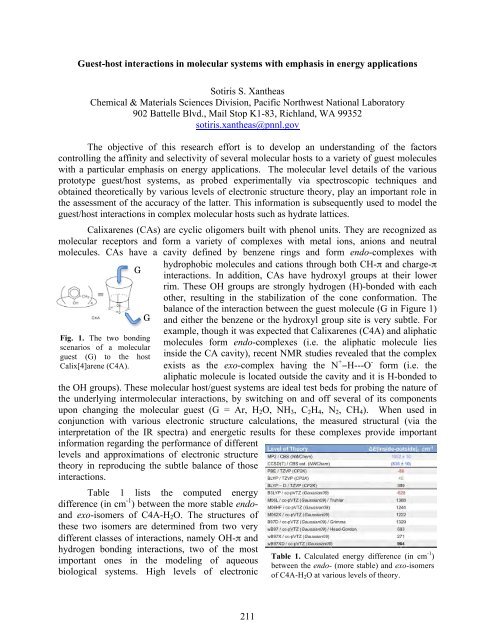Eighth Condensed Phase and Interfacial Molecular Science (CPIMS)
Eighth Condensed Phase and Interfacial Molecular Science (CPIMS)
Eighth Condensed Phase and Interfacial Molecular Science (CPIMS)
You also want an ePaper? Increase the reach of your titles
YUMPU automatically turns print PDFs into web optimized ePapers that Google loves.
Guest-host interactions in molecular systems with emphasis in energy applications<br />
Sotiris S. Xantheas<br />
Chemical & Materials <strong>Science</strong>s Division, Pacific Northwest National Laboratory<br />
902 Battelle Blvd., Mail Stop K1-83, Richl<strong>and</strong>, WA 99352<br />
sotiris.xantheas@pnnl.gov<br />
The objective of this research effort is to develop an underst<strong>and</strong>ing of the factors<br />
controlling the affinity <strong>and</strong> selectivity of several molecular hosts to a variety of guest molecules<br />
with a particular emphasis on energy applications. The molecular level details of the various<br />
prototype guest/host systems, as probed experimentally via spectroscopic techniques <strong>and</strong><br />
obtained theoretically by various levels of electronic structure theory, play an important role in<br />
the assessment of the accuracy of the latter. This information is subsequently used to model the<br />
guest/host interactions in complex molecular hosts such as hydrate lattices.<br />
Calixarenes (CAs) are cyclic oligomers built with phenol units. They are recognized as<br />
molecular receptors <strong>and</strong> form a variety of complexes with metal ions, anions <strong>and</strong> neutral<br />
molecules. CAs have a cavity defined by benzene rings <strong>and</strong> form endo-complexes with<br />
G<br />
G<br />
Fig. 1. The two bonding<br />
scenarios of a molecular<br />
guest (G) to the host<br />
Calix[4]arene (C4A).<br />
hydrophobic molecules <strong>and</strong> cations through both CH-π <strong>and</strong> charge-π<br />
interactions. In addition, CAs have hydroxyl groups at their lower<br />
rim. These OH groups are strongly hydrogen (H)-bonded with each<br />
other, resulting in the stabilization of the cone conformation. The<br />
balance of the interaction between the guest molecule (G in Figure 1)<br />
<strong>and</strong> either the benzene or the hydroxyl group site is very subtle. For<br />
example, though it was expected that Calixarenes (C4A) <strong>and</strong> aliphatic<br />
molecules form endo-complexes (i.e. the aliphatic molecule lies<br />
inside the CA cavity), recent NMR studies revealed that the complex<br />
exists as the exo-complex having the N + −H---O - form (i.e. the<br />
aliphatic molecule is located outside the cavity <strong>and</strong> it is H-bonded to<br />
the OH groups). These molecular host/guest systems are ideal test beds for probing the nature of<br />
the underlying intermolecular interactions, by switching on <strong>and</strong> off several of its components<br />
upon changing the molecular guest (G = Ar, H2O, NH3, C2H4, N2, CH4). When used in<br />
conjunction with various electronic structure calculations, the measured structural (via the<br />
interpretation of the IR spectra) <strong>and</strong> energetic results for these complexes provide important<br />
information regarding the performance of different<br />
levels <strong>and</strong> approximations of electronic structure<br />
theory in reproducing the subtle balance of those<br />
interactions.<br />
Table 1 lists the computed energy<br />
difference (in cm -1 ) between the more stable endo-<br />
<strong>and</strong> exo-isomers of C4A-H2O. The structures of<br />
these two isomers are determined from two very<br />
different classes of interactions, namely OH-π <strong>and</strong><br />
hydrogen bonding interactions, two of the most<br />
important ones in the modeling of aqueous<br />
biological systems. High levels of electronic<br />
211<br />
Table 1. Calculated energy difference (in cm -1 )<br />
between the endo- (more stable) <strong>and</strong> exo-isomers<br />
of C4A-H2O at various levels of theory.
















